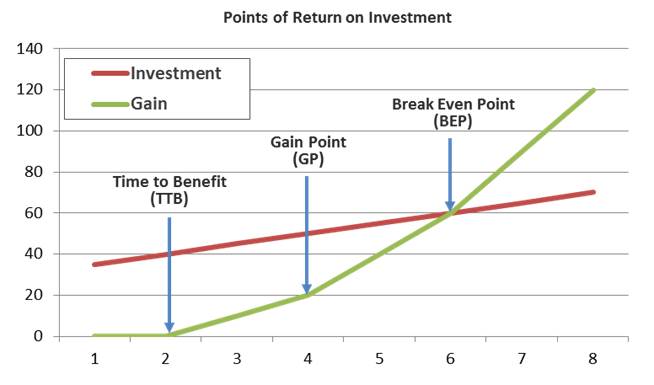What is Your Time to Benefit on Sales Enablement Investments?
We often get asked about ROI on sales investments. And no doubt that is an important question. Everyday chief sales officers are placing bets on where to invest the company’s money in order to grow sales. And, everyone cares about the outcome – the shareholders, the employees and certainly the sales leader and the sales force. Everyone wants to make good investments that generate high returns. As the Dreamforce conference approaches, all the exhibitors are planning their pitches now for how their CRM solution, demand gen strategy, enablement program or sales effectiveness tool will produce a high return on investment for you, the chief sales officer. You can guarantee they will hit you with a compelling ROI story.
But perhaps the more important part of the ROI question is the time to benefit – the amount of time it will take before you begin to realize gains. How soon will the investments you make and the changes you undertake move the needle on sales productivity? In most cases, the time to benefit factor outweighs even the loftiest of ROI estimates. This is because most sales leaders are under incredible pressure to make an impact now, in the short term, as in this quarter or next. Anything beyond that is interesting but seems to test the patience of CFOs, CEOs and certainly the street. This makes the time to benefit factor more critical than overall ROI.
Time to benefit (TTB) is different than the break-even point (BEP) as time to benefit occurs sooner than break-even, as soon as you begin to realize gains. Time to benefit is usually measured in the number of days, weeks, months, or quarters needed to begin to realize productivity gains on your investment outlay. Another important point on the chart is the Gain Point. This is the point where the slope of the accretive gains or return on your investment begins to exceed the slope of continued incremental costs. In the case where investments are all 100% upfront, this point is the same as time to benefit. But many investments involve on-going costs in which case the Gain Point becomes more interesting. These are helpful markers for sales leaders as they provide an earlier indication of impact on sales and sales enablement investments.
 So what is the time to benefit for your investments in sales? The answer naturally will depend on a variety of factors. Is the investment a quota carrying headcount? Is it a program or support resource intended to raise sales rep productivity? Or is it a significant change to the go-to-market strategy? The results will also vary based on the level of resource involved. Investments in strategic and enterprise account sales typically have a longer time to benefit due to longer sales cycles than investments in retail or SMB sales. Below are guidelines we have compiled at the Alexander Group that depict the time to benefit, break-even point and first year ROI you should expect from investments in corporate (mid-market to enterprise) sales efforts.
So what is the time to benefit for your investments in sales? The answer naturally will depend on a variety of factors. Is the investment a quota carrying headcount? Is it a program or support resource intended to raise sales rep productivity? Or is it a significant change to the go-to-market strategy? The results will also vary based on the level of resource involved. Investments in strategic and enterprise account sales typically have a longer time to benefit due to longer sales cycles than investments in retail or SMB sales. Below are guidelines we have compiled at the Alexander Group that depict the time to benefit, break-even point and first year ROI you should expect from investments in corporate (mid-market to enterprise) sales efforts.
Notice that the break-even point is usually 6 months or longer. This means most investments that chief sales officers are making require at least two quarters to make up for the cost of the investment, and in some cases three or four. However, notice also that the time to benefit is much shorter, usually 3 months or less. This means that measuring and tracking time to benefit provides the chief sales officer an opportunity to demonstrate the impact that sales investments are making within one or two quarters.
How do these figures compare to the results you’ve seen with your sales force? Keep in mind that it is difficult to compare results in isolation of the many other factors at work in a particular company and industry. In a sense these results assume a degree of ceteris paribus (all other things held constant) or a degree of normalcy with regard to broader product, marketing, supply and demand issues. If your sales investments have not realized at least the returns described above, it could be your fault – i.e., poor talent, poor program selection or poor program execution. But it could also be impacted by product, supply or market demand issues. Unfortunately, as the chief sales officer you’ll likely take the heat for poor results either way. Let us know how we can help you.
Learn more about return on sales investment and Alexander Group’s Commercial Analytics practice.
